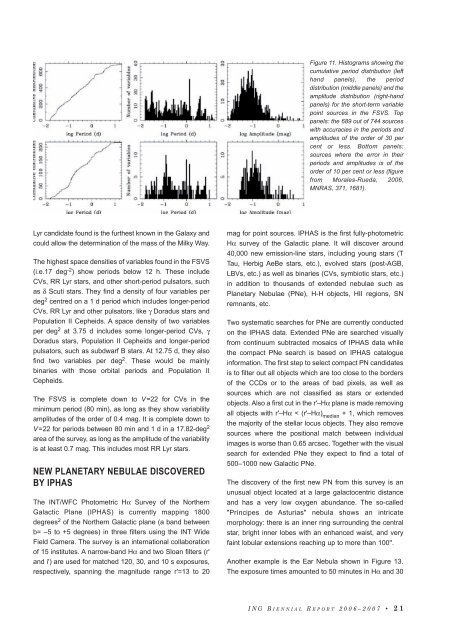PDF (6M) - Isaac Newton Group of Telescopes - Instituto de ...
PDF (6M) - Isaac Newton Group of Telescopes - Instituto de ...
PDF (6M) - Isaac Newton Group of Telescopes - Instituto de ...
Create successful ePaper yourself
Turn your PDF publications into a flip-book with our unique Google optimized e-Paper software.
Figure 11. Histograms showing the<br />
cumulative period distribution (left<br />
hand panels), the period<br />
distribution (middle panels) and the<br />
amplitu<strong>de</strong> distribution (right-hand<br />
panels) for the short-term variable<br />
point sources in the FSVS. Top<br />
panels: the 689 out <strong>of</strong> 744 sources<br />
with accuracies in the periods and<br />
amplitu<strong>de</strong>s <strong>of</strong> the or<strong>de</strong>r <strong>of</strong> 30 per<br />
cent or less. Bottom panels:<br />
sources where the error in their<br />
periods and amplitu<strong>de</strong>s is <strong>of</strong> the<br />
or<strong>de</strong>r <strong>of</strong> 10 per cent or less (figure<br />
from Morales-Rueda, 2006,<br />
MNRAS, 371, 1681).<br />
Lyr candidate found is the furthest known in the Galaxy and<br />
could allow the <strong>de</strong>termination <strong>of</strong> the mass <strong>of</strong> the Milky Way.<br />
The highest space <strong>de</strong>nsities <strong>of</strong> variables found in the FSVS<br />
(i.e.17 <strong>de</strong>g -2 ) show periods below 12 h. These inclu<strong>de</strong><br />
CVs, RR Lyr stars, and other short-period pulsators, such<br />
as δ Scuti stars. They find a <strong>de</strong>nsity <strong>of</strong> four variables per<br />
<strong>de</strong>g 2 centred on a 1 d period which inclu<strong>de</strong>s longer-period<br />
CVs, RR Lyr and other pulsators, like γ Doradus stars and<br />
Population II Cepheids. A space <strong>de</strong>nsity <strong>of</strong> two variables<br />
per <strong>de</strong>g 2 at 3.75 d inclu<strong>de</strong>s some longer-period CVs, γ<br />
Doradus stars, Population II Cepheids and longer-period<br />
pulsators, such as subdwarf B stars. At 12.75 d, they also<br />
find two variables per <strong>de</strong>g 2 . These would be mainly<br />
binaries with those orbital periods and Population II<br />
Cepheids.<br />
The FSVS is complete down to V=22 for CVs in the<br />
minimum period (80 min), as long as they show variability<br />
amplitu<strong>de</strong>s <strong>of</strong> the or<strong>de</strong>r <strong>of</strong> 0.4 mag. It is complete down to<br />
V=22 for periods between 80 min and 1 d in a 17.82-<strong>de</strong>g 2<br />
area <strong>of</strong> the survey, as long as the amplitu<strong>de</strong> <strong>of</strong> the variability<br />
is at least 0.7 mag. This inclu<strong>de</strong>s most RR Lyr stars.<br />
NEW PLANETARY NEBULAE DISCOVERED<br />
BY IPHAS<br />
The INT/WFC Photometric Hα Survey <strong>of</strong> the Northern<br />
Galactic Plane (IPHAS) is currently mapping 1800<br />
<strong>de</strong>grees 2 <strong>of</strong> the Northern Galactic plane (a band between<br />
b= –5 to +5 <strong>de</strong>grees) in three filters using the INT Wi<strong>de</strong><br />
Field Camera. The survey is an international collaboration<br />
<strong>of</strong> 15 institutes. A narrow-band Hα and two Sloan filters (r'<br />
and i') are used for matched 120, 30, and 10 s exposures,<br />
respectively, spanning the magnitu<strong>de</strong> range r'=13 to 20<br />
mag for point sources. IPHAS is the first fully-photometric<br />
Hα survey <strong>of</strong> the Galactic plane. It will discover around<br />
40,000 new emission-line stars, including young stars (T<br />
Tau, Herbig AeBe stars, etc.), evolved stars (post-AGB,<br />
LBVs, etc.) as well as binaries (CVs, symbiotic stars, etc.)<br />
in addition to thousands <strong>of</strong> exten<strong>de</strong>d nebulae such as<br />
Planetary Nebulae (PNe), H-H objects, HII regions, SN<br />
remnants, etc.<br />
Two systematic searches for PNe are currently conducted<br />
on the IPHAS data. Exten<strong>de</strong>d PNe are searched visually<br />
from continuum subtracted mosaics <strong>of</strong> IPHAS data while<br />
the compact PNe search is based on IPHAS catalogue<br />
information. The first step to select compact PN candidates<br />
is to filter out all objects which are too close to the bor<strong>de</strong>rs<br />
<strong>of</strong> the CCDs or to the areas <strong>of</strong> bad pixels, as well as<br />
sources which are not classified as stars or exten<strong>de</strong>d<br />
objects. Also a first cut in the r'–Hα plane is ma<strong>de</strong> removing<br />
all objects with r'–Hα < (r'–Hα) median<br />
+ 1, which removes<br />
the majority <strong>of</strong> the stellar locus objects. They also remove<br />
sources where the positional match between individual<br />
images is worse than 0.65 arcsec. Together with the visual<br />
search for exten<strong>de</strong>d PNe they expect to find a total <strong>of</strong><br />
500–1000 new Galactic PNe.<br />
The discovery <strong>of</strong> the first new PN from this survey is an<br />
unusual object located at a large galactocentric distance<br />
and has a very low oxygen abundance. The so-called<br />
"Príncipes <strong>de</strong> Asturias" nebula shows an intricate<br />
morphology: there is an inner ring surrounding the central<br />
star, bright inner lobes with an enhanced waist, and very<br />
faint lobular extensions reaching up to more than 100''.<br />
Another example is the Ear Nebula shown in Figure 13.<br />
The exposure times amounted to 50 minutes in Hα and 30<br />
ING BIENNIAL R EPORT 2006–2007 • 21
















